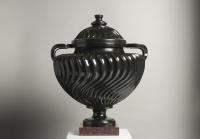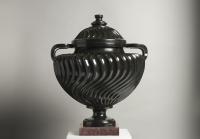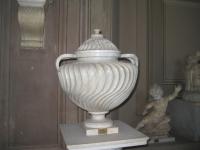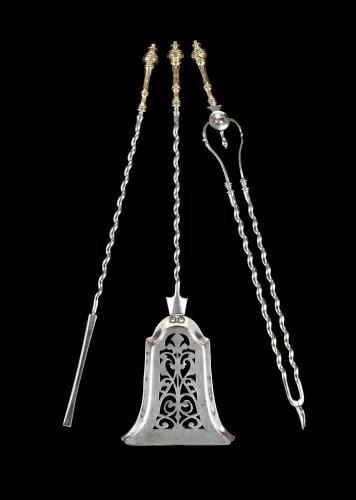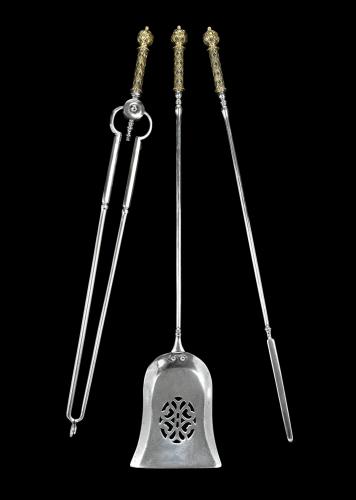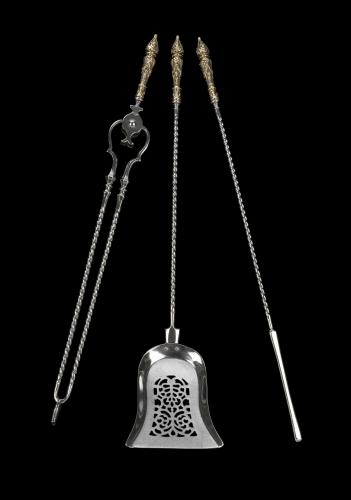
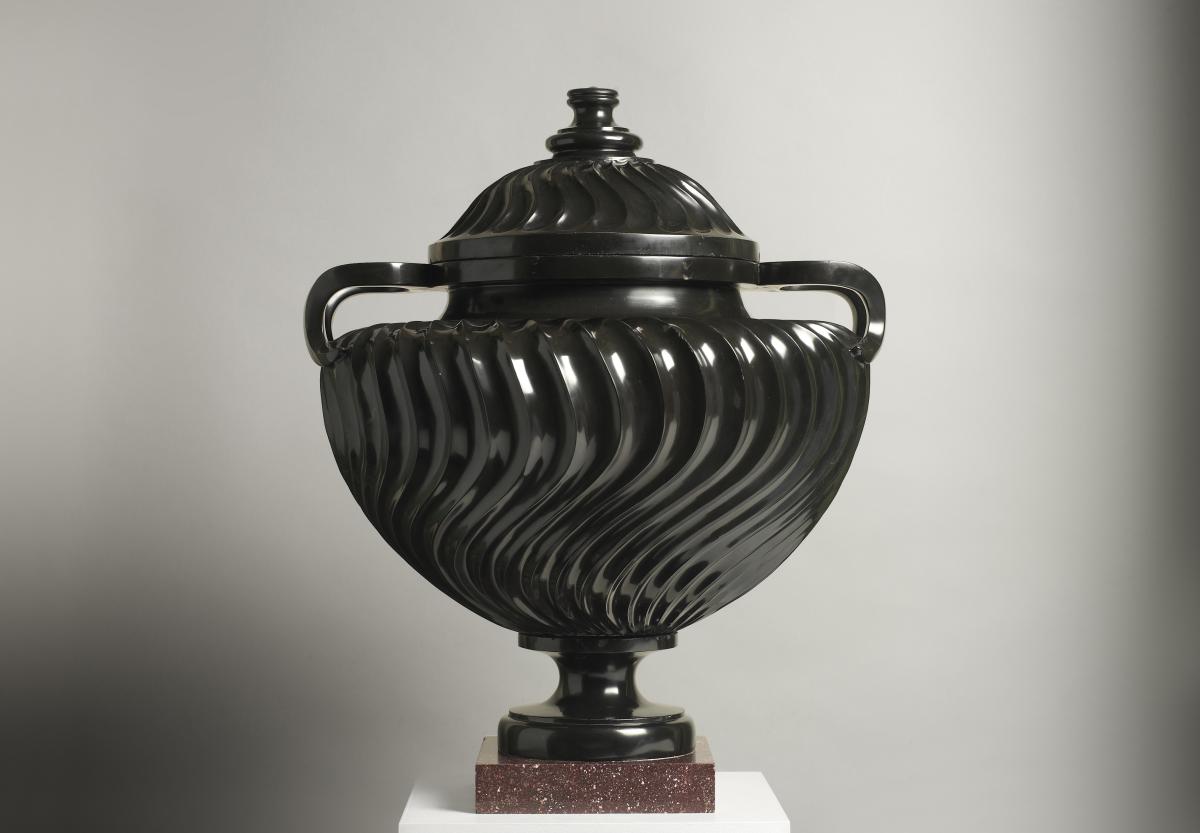
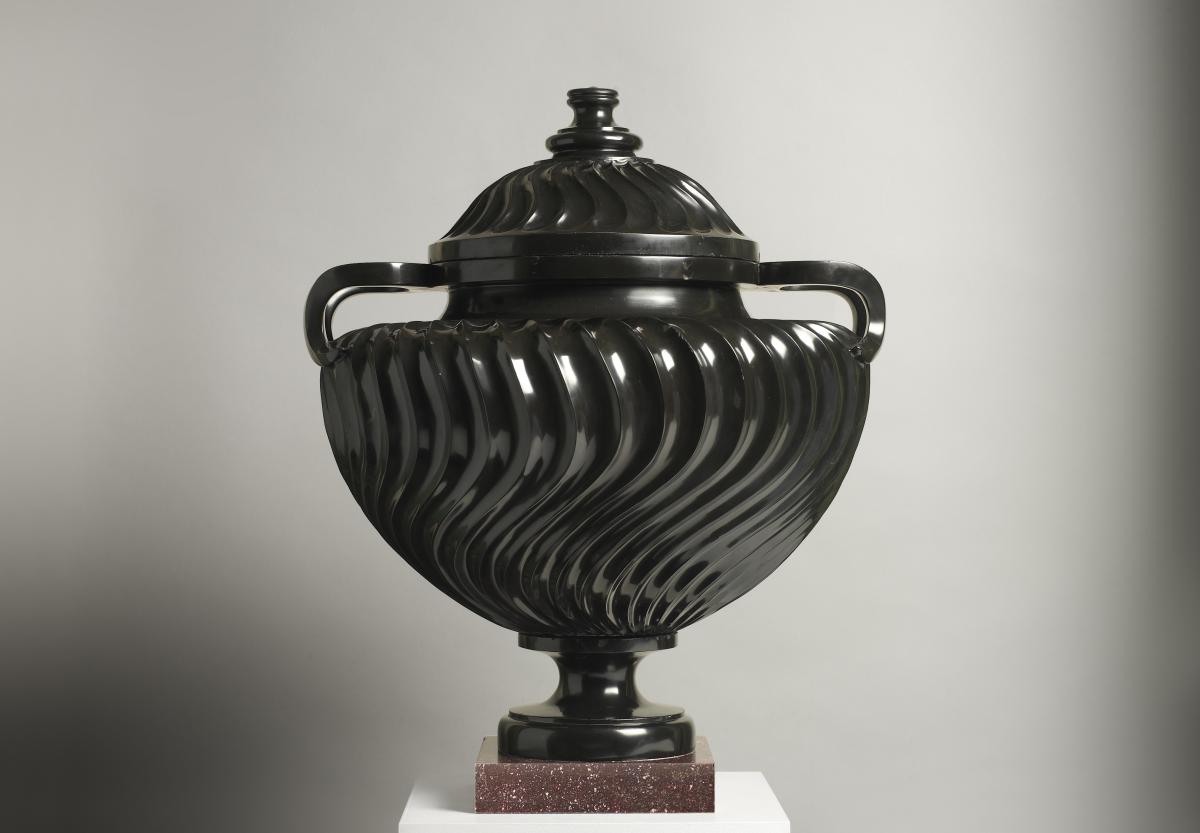
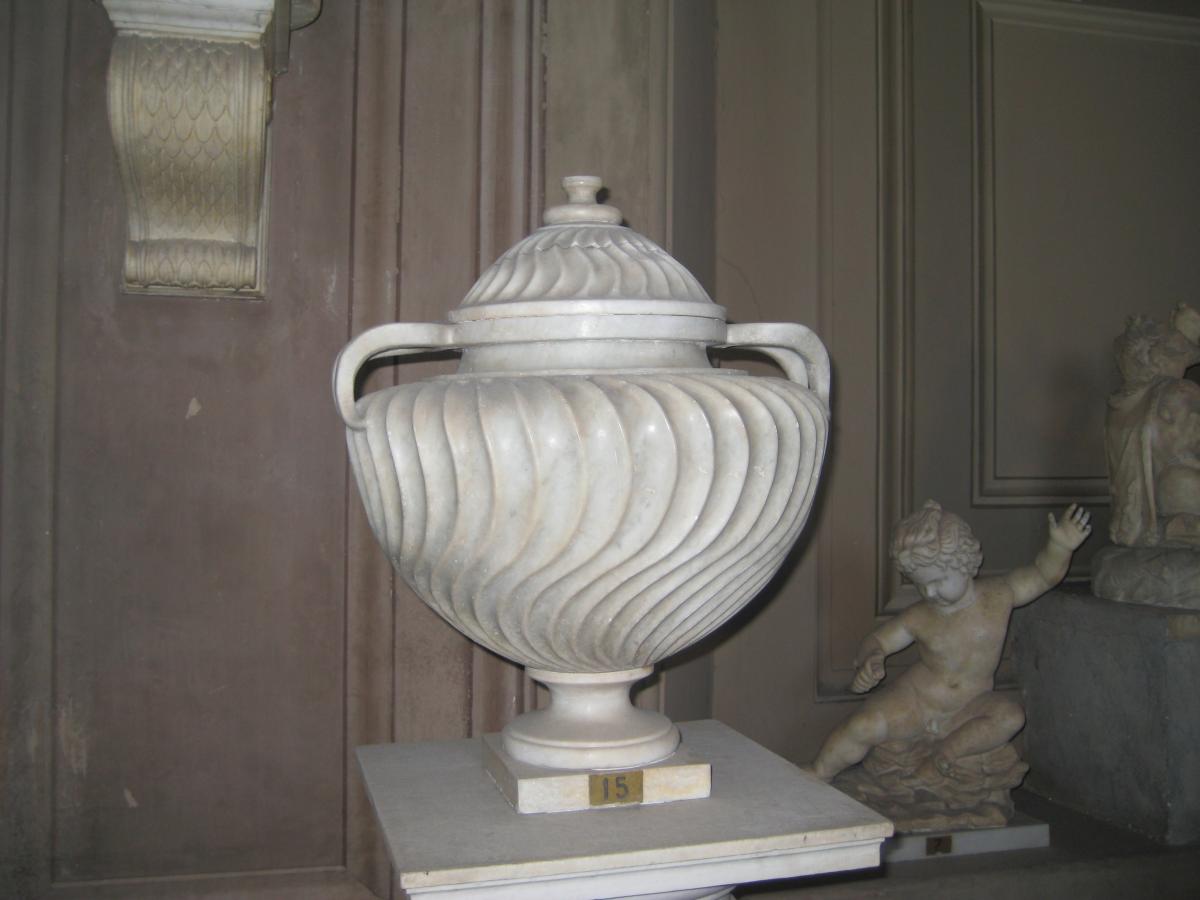
Price on application
This object is eligible for a Certificate of BADA Provenance
The BADA Standard
- Since 1918, BADA has been the leading association for the antiques and fine art trade
- Members are elected for their knowledge, integrity and quality of stock
- Our clients are protected by BADA’s code of conduct
- Our dealers’ membership is reviewed and renewed annually
- Bada.org is a non-profit site: clients deal directly with members and they pay no hidden fees
A Magnificent Pair of Late Louis XVI Black Marble Vases, Attributed to Charles de Wailly Circa 1790.
The urns are circular in plan, with their bodies spirally fluted (or ‘strigillated’, to use the Roman description for this type of ornament from its similarity to the shape of a strigil, the metal instrument used to scrape clean the body after bathing and oiling). They have pierced and looped double handles and domed, strigillated lids with finials, and are set on turned waisted feet above square bases of solid porphyry. The stone out of which they have been laboriously and ingeniously carved is commonly known as Belgian black marble (or, in French, ‘petit granit’, and Italian, ‘nero di Belgio’), but is not a true marble: rather, it is a limestone that is in fact far harder than marble and contains small fossil inclusions (notably brachiopods) that appear whitish, compared with its general grey-black hue. It also contains a high hydrocarbon content and bituminous matter, which is responsible for the high gloss and velvety finish on polished items, such as these. As pointed out by Woodall Minerals, “With just these two factors taken into consideration, it is possible to identify the origin of the material without chemical analysis or further testing of the rock”. The bodies have been fashioned by painstaking and accurate manual carving, for – on account of the projecting handles - they cannot have been turned on a lathe.The period of maximum usage of Belgian black marble based on the records of the various quarries in southern Belgium suggests a date span of 1740-1780, and a ‘modern’ origin can be virtually excluded, as the quarries became exhausted by 1912. A classical original has recently been discovered for these urns, which had previously been regarded as clever 18th century adaptations of various other, similar, strigillated ancient Roman cinerary urns, as illustrated by Piranesi and others. In the Galleria dei Candelabri of the Museo Pio-Clementino in the Musei Vaticani, it is described in the latest catalogue as follows:
The vase, carved in a white alabaster-like marble, is complete and almost entirely ancient, save for a reduced integration of the lid. The container is hemispherical, with double handles running down from its neck to the shoulders, and has a conical lid; both body and lid are decorated with a spiralling strigil pattern, while foot and neck are plain. It is a cinerary urn (i.e. for the ashes of a cremated corpse), elegant and well carved, which seems datable to the second half of the 1st century A.D.[1]
Though their design is based directly on the original in Rome, the choice of Belgian black stone in which to carve the copies indicates an origin near the quarries in the Walloon or Francophone area, now in Belgium. For such an elaborate and challenging project – with the patronage to commission and pay for such de luxe ornaments - the most likely centre at the time is clearly Paris. The most likely candidate as designer is the architect Charles de Wailly (1730-1798), one of the most important and well-regarded of the second half of the eighteenth century, the ‘Age of Enlightenment’. One of the earliest and influential exponents of Neo-Classicism, De Wailly won the Prix de Rome of the French Royal Academy soon after 1750 and was thus privileged to spend some years in the Eternal City, pursuing the study of his chosen art, architecture and interior design. There he would have met Piranesi, the great Neo-Classical sculptor-antiquarian-author, in whose engravings vases similar to the present ones appear several times, as well as the painter Hubert Robert and the Scot, Robert Adam. After his return to Paris, finding the architectural climate depressed, De Wailly designed interiors and furnishings in the fashionable Gout grec – ‘the Greek Taste’. Into this particular niche in his production the present, rather austere, ‘Grecian’ urns conveniently fit, even if their prototype was actually ancient Roman, rather than Greek.
These vases belong at the very end of the Ancien Regime. They are of the very finest technical quality: a combination of chiselling, grinding and rifling of a difficult and very hard material… Indeed, vases were, as Josiah Wedgwood described, something of a “maniacal desire” in his time. They took many forms and were made of a wide variety of materials. The most expensive, however, were those made in hard [stones] such as porphyry”. To the latter class and for the same reasons may be added the Belgian black stone from which the present urns are hewn, though it was not of course as expensive as porphyry, a material restricted in the ancient world to imperial use, and in the early modern period to the re-use of surviving specimens from of old that had been transported to Rome.
[1] Musei Vaticani
Galleria dei Candelabri, sez. II, 15. Urna cineraria a vaso marmoreo strigilato
Il vaso, scolpito in un marmo bianco alabastrino, è completo e quasi del tutto antico, presentando solo una ridotta integrazione del coperchio. Il contenitore è di forma emisferica, con doppie anse rimontanti sull’orlo e coperchio conico; sia il corpo che il coperchio sono decorati da strigilature, mentre il piede ed il collo sono lisci. Si tratta di un’urna cineraria, elegante e di buona fattura, che sembra databile alla seconda metà del I sec. d.C.The urns are circular in plan, with their bodies spirally fluted (or ‘strigillated’, to use the Roman description for this type of ornament from its similarity to the shape of a strigil, the metal instrument used to scrape clean the body after bathing and oiling). They have pierced and looped double handles and domed, strigillated lids with finials, and are set on turned waisted feet above square bases of solid porphyry. The stone out of which they have been laboriously and ingeniously carved is commonly known as Belgian black marble (or, in French, ‘petit granit’, and Italian, ‘nero di Belgio’), but is not a true marble: rather, it is a limestone that is in fact far harder than marble and contains small fossil inclusions (notably brachiopods) that appear whitish, compared with its general grey-black hue. It also contains a high hydrocarbon content and bituminous matter, which is responsible for the high gloss and velvety finish on polished items, such as these. As pointed out by Woodall Minerals, “With just these two factors taken into consideration, it is possible to identify the origin of the material without chemical analysis or further testing of the rock”. The bodies have been fashioned by painstaking and accurate manual carving, for – on account of the projecting handles - they cannot have been turned on a lathe.The period of maximum usage of Belgian black marble based on the records of the various quarries in southern Belgium suggests a date span of 1740-1780, and a ‘modern’ origin can be virtually excluded, as the quarries became exhausted by 1912. A classical original has recently been discovered for these urns, which had previously been regarded as clever 18th century adaptations of various other, similar, strigillated ancient Roman cinerary urns, as illustrated by Piranesi and others. In the Galleria dei Candelabri of the Museo Pio-Clementino in the Musei Vaticani, it is described in the latest catalogue as follows:
The vase, carved in a white alabaster-like marble, is complete and almost entirely ancient, save for a reduced integration of the lid. The container is hemispherical, with double handles running down from its neck to the shoulders, and has a conical lid; both body and lid are decorated with a spiralling strigil pattern, while foot and neck are plain. It is a cinerary urn (i.e. for the ashes of a cremated corpse), elegant and well carved, which seems datable to the second half of the 1st century A.D.[1]
Though their design is based directly on the original in Rome, the choice of Belgian black stone in which to carve the copies indicates an origin near the quarries in the Walloon or Francophone area, now in Belgium. For such an elaborate and challenging project – with the patronage to commission and pay for such de luxe ornaments - the most likely centre at the time is clearly Paris. The most likely candidate as designer is the architect Charles de Wailly (1730-1798), one of the most important and well-regarded of the second half of the eighteenth century, the ‘Age of Enlightenment’. One of the earliest and influential exponents of Neo-Classicism, De Wailly won the Prix de Rome of the French Royal Academy soon after 1750 and was thus privileged to spend some years in the Eternal City, pursuing the study of his chosen art, architecture and interior design. There he would have met Piranesi, the great Neo-Classical sculptor-antiquarian-author, in whose engravings vases similar to the present ones appear several times, as well as the painter Hubert Robert and the Scot, Robert Adam. After his return to Paris, finding the architectural climate depressed, De Wailly designed interiors and furnishings in the fashionable Gout grec – ‘the Greek Taste’. Into this particular niche in his production the present, rather austere, ‘Grecian’ urns conveniently fit, even if their prototype was actually ancient Roman, rather than Greek.
These vases belong at the very end of the Ancien Regime. They are of the very finest technical quality: a combination of chiselling, grinding and rifling of a difficult and very hard material… Indeed, vases were, as Josiah Wedgwood described, something of a “maniacal desire” in his time. They took many forms and were made of a wide variety of materials. The most expensive, however, were those made in hard [stones] such as porphyry”. To the latter class and for the same reasons may be added the Belgian black stone from which the present urns are hewn, though it was not of course as expensive as porphyry, a material restricted in the ancient world to imperial use, and in the early modern period to the re-use of surviving specimens from of old that had been transported to Rome.
[1] Musei Vaticani
Galleria dei Candelabri, sez. II, 15. Urna cineraria a vaso marmoreo strigilato
Il vaso, scolpito in un marmo bianco alabastrino, è completo e quasi del tutto antico, presentando solo una ridotta integrazione del coperchio. Il contenitore è di forma emisferica, con doppie anse rimontanti sull’orlo e coperchio conico; sia il corpo che il coperchio sono decorati da strigilature, mentre il piede ed il collo sono lisci. Si tratta di un’urna cineraria, elegante e di buona fattura, che sembra databile alla seconda metà del I sec. d.C.
Dimensions
50 x 60cm HighThe BADA Standard
- Since 1918, BADA has been the leading association for the antiques and fine art trade
- Members are elected for their knowledge, integrity and quality of stock
- Our clients are protected by BADA’s code of conduct
- Our dealers’ membership is reviewed and renewed annually
- Bada.org is a non-profit site: clients deal directly with members and they pay no hidden fees


